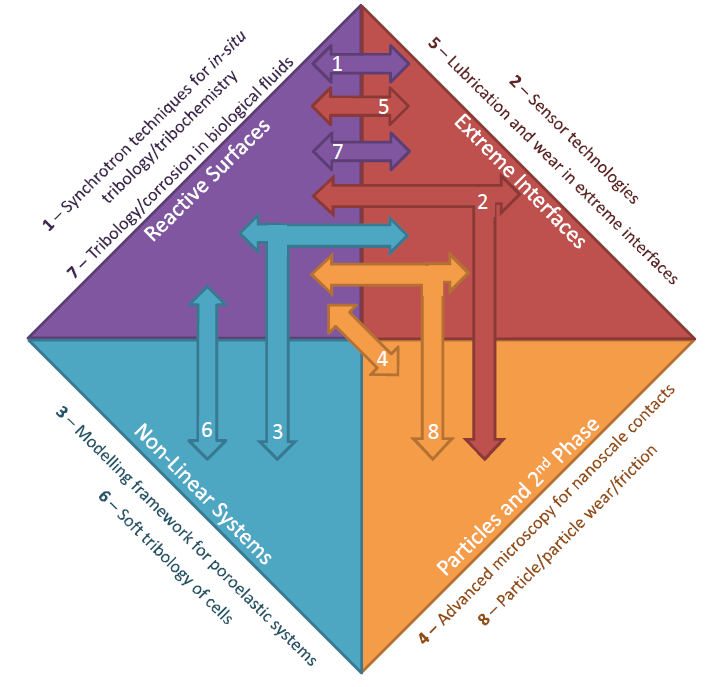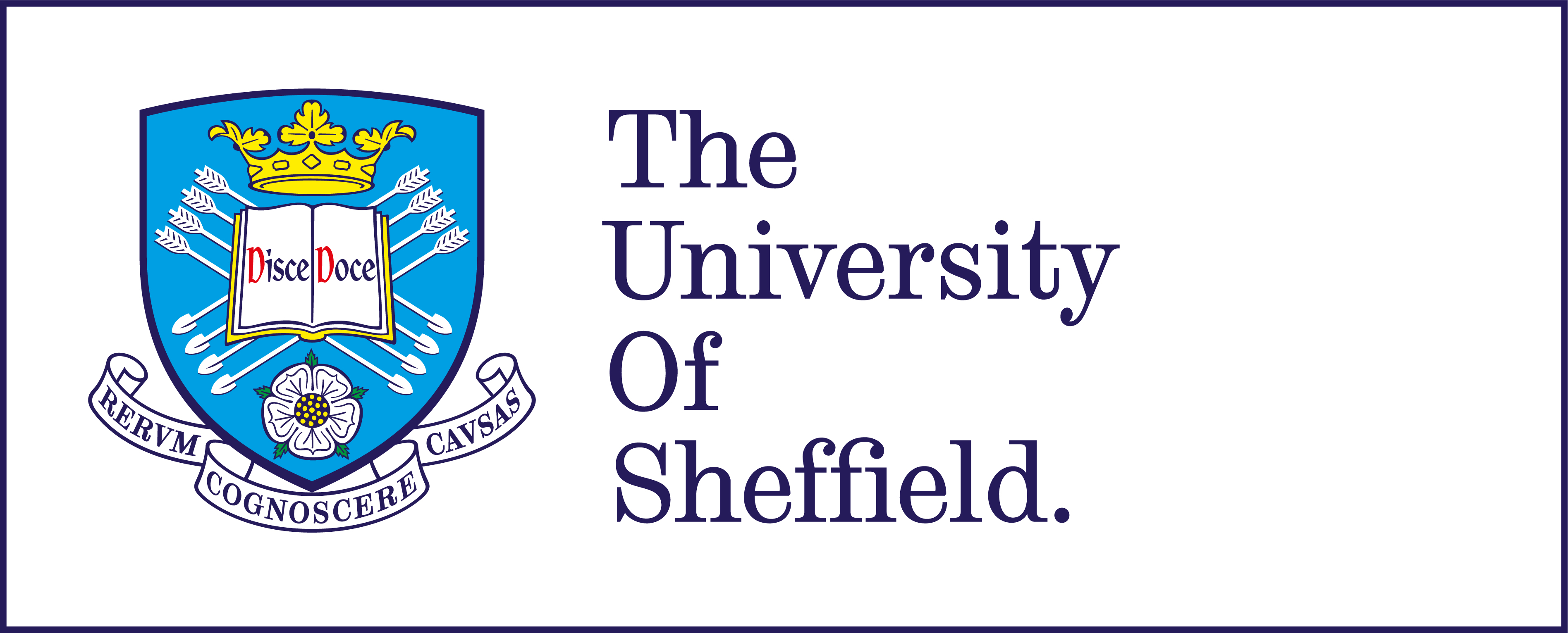Challenge 1 - Reactive Surfaces
It is because tribological processes have complex effects on the reaction pathways and on the reaction kinetics that tribochemistry and tribocorrosion are sub disciplines of tribology. Many words are used to convey the general meaning that tribo processes can activate chemical or electrochemical reactions (mechanochemistry, triboactivation) and where reactive surfaces become hugely important is when asperity-asperity contact occurs, whether wholly (as in dry conditions) or in boundary lubrication (where there is solid-solid contact and an intermittent lubricating film). In such conditions it is understood that films are formed/destructed and the resulting intimate reactions between the surfaces, and the surrounding species in the environment, have a very important role on friction and on wear processes. The team between Leeds and Sheffield have a vast expertise across a diverse range of application areas including:
- Tribochemistry of conventional steels and the realisation the surface/lubricant reactions can result in widely different “tribofilms” depending on the conditions and the environment (Neville/Morina1/Armes) - Developing a semi-deterministic framework for adding tribochemistry to solid-solid asperity contact mechanics models (Wilson/Neville/Morina2)
- Understanding near surface reactions at C-based materials in dry and lubricated conditions (Brydson/Neville/Morina/Rainforth/Armes)
- Developing in-situ techniques for following surface chemistry due to tribochemical and tribocorrosion processes (Morina/Neville/Mangolini/Bryant)
- Understanding ceramic/environment phase changes and interactions in complex biological and non-biological environments (Rainforth3/Neville)
 Across the tribology community there is a large focus on characterising the nature and kinetics of surface reactions in tribological interfaces. From the wealth of published information the Leeds and Sheffield teams point to some examples of current pioneering work as; (a) the work by Carpick et al. in UPenn on use of scanning probe techniques to understand surface transformations, (b) the modelling work from Lulea4 which brings tribochemistry into the modelling area, (c) molecular dynamics work<sup>5</sup> at Tohuko in collaboration with L’Ecole Centrale aiming to simulate reactions in tribochemical interfaces, and (d) the in-situ work across the community looking at in real-time at surface reactions. For this PG “reactivity at surfaces” is a common thread in many of the projects (see challenge overlap opposite) however two specific projects, that Leeds and Sheffield team believe they have the expertise and unique combination of skills to deliver successful outcomes, have been identified to be in the Reactive Surfaces challenge.
Across the tribology community there is a large focus on characterising the nature and kinetics of surface reactions in tribological interfaces. From the wealth of published information the Leeds and Sheffield teams point to some examples of current pioneering work as; (a) the work by Carpick et al. in UPenn on use of scanning probe techniques to understand surface transformations, (b) the modelling work from Lulea4 which brings tribochemistry into the modelling area, (c) molecular dynamics work<sup>5</sup> at Tohuko in collaboration with L’Ecole Centrale aiming to simulate reactions in tribochemical interfaces, and (d) the in-situ work across the community looking at in real-time at surface reactions. For this PG “reactivity at surfaces” is a common thread in many of the projects (see challenge overlap opposite) however two specific projects, that Leeds and Sheffield team believe they have the expertise and unique combination of skills to deliver successful outcomes, have been identified to be in the Reactive Surfaces challenge.
It is still impossible to predict between tribological interfaces what chemical reactions will occur and their rate. This presents a major barrier to being able to predict friction when reactions are occurring at the interface. Tribo- or mechano-activation processes, which are often not in equilibrium, are a subject of much debate. Crucially, frictional changes in sliding interfaces depend on the creation of reactions films, their removal, subsequent entrainment of species and wear. In order to dig deep into the reaction kinetics in an experimental framework, so that parameters such as xtribo (Bulgaravich)6 can be validated, there is a need to be able to follow surface reactions in real-time. Synchrotron-based real-time tribometry will facilitate this for some specific systems in this PG. Project 1 will build on Proof-of-Concept work (Dorgham/Morina/Neville)7 to develop a methodology for measuring tribofilm chemical changes in real-time and in ambient (non-vacuum) conditions in collaboration with the beamline scientists (Mosselmans/Ignatyev) at Diamond. This project will optimise the in-situ tribometry for analysis of tribofilms formed from next generation low Sulphated Ash Phosphorous and Sulphur (SAPS) oils. The scientific questions to be answered relate to the kinetics of tribofilm build-up and the influence of organic oil additives on the S- and P-containing elements of the film and how water as a contaminant in oils affects the S and P-containing film chemistry and kinetics.
The tribology of hip joints has been studied since the early implants of Charnley, and Dowson (Leeds) played a pioneering role in the development of lubrication models for their bearing surfaces. More recently, Fisher et al8 has measured the wear resistance of current and new materials using realistic simulation conditions. Much of the early work, including that in Leeds, ignored the fact that implanted joints are in an environment where the lubricating fluid is saline, is at 37°C and can react with the nascent surfaces created from asperity contact. This is significant because (i) it means that corrosion (electrochemical charge transfer – tribocorrosion) occurs and changes the local environment and (ii) the released ions and subsequent reaction products have a large influence on the friction and wear evolution on the surface. Similarly, there are questions relating to the reactivity of ceramic systems and an analogous role that chemistry plays in the mechanical transformations. Although ceramics are generally considered to be inert, there is mounting evidence that chemical and structural changes induced by frictional contact result in important changes to the surface that can then influence subsequent performance. Early work showed that plastic deformation via dislocation flow at the surface of alumina ceramics is responsible for the time dependent wear transition and demonstrated that the surface grains behaved quite differently to that of the bulk. Moreover, it showed that a tribolayer forms on the surface of alumina much in the same way that is observed on metals. This layer is intimately integrated with the surface and must therefore have a strong influence on friction. Later, it was demonstrated the key role that oxygen vacancies play in the tribology of alumina ceramics. Remarkably, the lubricant (e.g. serum) can extract oxygen from the alumina, leaving a vacancy structure at the alumina surface. Also, some accentuation of degradation in polyethylene surfaces has been attributed to the synergy between wear and corrosion. Interestingly, the presence of Cr in Biolox Delta™ significantly reduces this oxygen loss, which may well be a hitherto unknown reason why that the material performs so well. These observations are new and suggest a radical new way of exploring the friction and wear of ceramics. Developing further understanding will require a combination of high resolution characterization techniques, both structural and spectroscopic. Based on work from Leeds and Sheffield we can challenge the notion that “bedding–in wear” is a purely mechanical process. In this challenge we specifically want to investigate the thin C-rich reaction film that is formed as a result of the surface/environment (protein/amino acids) interactions at an asperity level. The work of Hesketh et al9, and more recently Bryant et al<sup>10</sup>, has demonstrated that the “tribofilms” formed at metallic contacts have got components of the Co-material and the proteins but are not a simple stoichiometric compound mimicking the protein composition. The role of the denaturing process and how this links to the simultaneous release of Co ions into solution requires attention. In a similar manner there are questions relating to the reactivity of ceramic systems and an analogous role that chemistry plays in the mechanical transformations seen. In fact some accentuation of degradation in polyethylene surfaces has been attributed to the synergy between wear and corrosion. In this challenge we bring together expertise in tribocorrosion/tribochemistry of metals and ceramics (Neville/Rainforth) with expertise in C-base materials (Brydson) and organic molecules (Perrault/Armes). Understanding the surface structural changes is central to explaining the materials performance. We have extensive expertise in site-specific Focused Ion Beam (FIB) microscopy and subsequent high resolution TEM to explore the physical structure of surfaces. We will make use of the new cryo-FIB system (EP/P0122X/1). Of particular importance is the use of high-resolution Electron Energy Loss (EEL) data from key locations within the structure (e.g. surface reaction layers). The near-edge structure (ELNES) of an EEL spectrum can be used to determine local bonding and oxidation state of the atoms.
Personnel
Co-Investigators
- Prof. Mark Rainforth – Challenge Leader
- Prof. Ardian Morina – Challenge Leader
- Prof. Anne Neville
- Dr. Mark Wilson
- Prof. Steve Armes
- Prof. Rik Drummond-Brydson
- Dr. Adrian Leyland
- Prof. Beverley Inkson
- Dr Shahriar Kosarieh
- Dr Farnaz Motamen Salehi
Postdoctoral Staff
- Dr. Abdel Dorgham (50%) & Dr. Pourya Parsaeian (50%) – Project 1
- Dr Jiahui Qi
1A. Morina, A. Neville, J. H. Green & M. Priest, ZDDP and MoDTC interactions and their effect on tribological performance–tribofilm characteristics and its evolution, Tribology Letters, 24 (3), pp. 243-256, DEC 2006
2A. Ghanbarzadeh, M Wilson, A Morina, D Dowson, A Neville, Development of a new mechano-chemical model in boundary lubrication, Tribology International, Vol 93, Part B, Jan 2016
3W. Mark Rainforth, Peng Zeng, Le Ma, Akemi Nogiwa Valdez, Todd Stewart, Dynamic surface microstructural changes during tribological contact that determine the wear behaviour of hip prostheses: metals and ceramics, Faraday Discuss., 2012,156, 41-57
4J Andersson,R Larsson, A Almqvist,M Grahn, I Minami, Semi-deterministic chemo-mechanical model of boundary lubrication Faraday Discuss., 2012,156, 343-360
5H Murabayashi, T Tsuruda, Y Wang, Y Kobayashi, S Bai, Y Higuchi, N Ozawa, K Adachi, and M Kubo, Tribo-Chemical Reaction of Molybdenum Dithiocarbamate on Diamond-Like Carbon Films: Quantum Chemical Molecular Dynamics Simulation, Journal of Computer Chemistry, Japan, 13 (2014) 117-118.
6S Bulgarevich, MV Boiko, E N Tarasova, V A Feizova, K S Lebedinskii, Kinetics of mechanoactivation or tribochemical processes, Journal of Friction and Wear, 2012, Vol 33, No 5.
7A. Dorgham, A. Neville, K. Ignatyev, F. Mosselmans, A. Morina, An in situ synchrotron XAS methodology for surface analysis under high temperature, pressure, and shear, Review of Scientific Instruments , Vol. 88, Issue 1, December 2016
8MN Harun, F CWang, Z M Jin, J Fisher, Long-term contact-coupled wear prediction for metal-on-metal total hip joint replacement, Proc I Mech E, Journal of Tribology, Vol 223, Issue 7, 2009.
9J Hesketh, PhD Thesis, University of Leeds, 2014
10M G Bryant, PhD Thesis, University of Leeds, 2015


